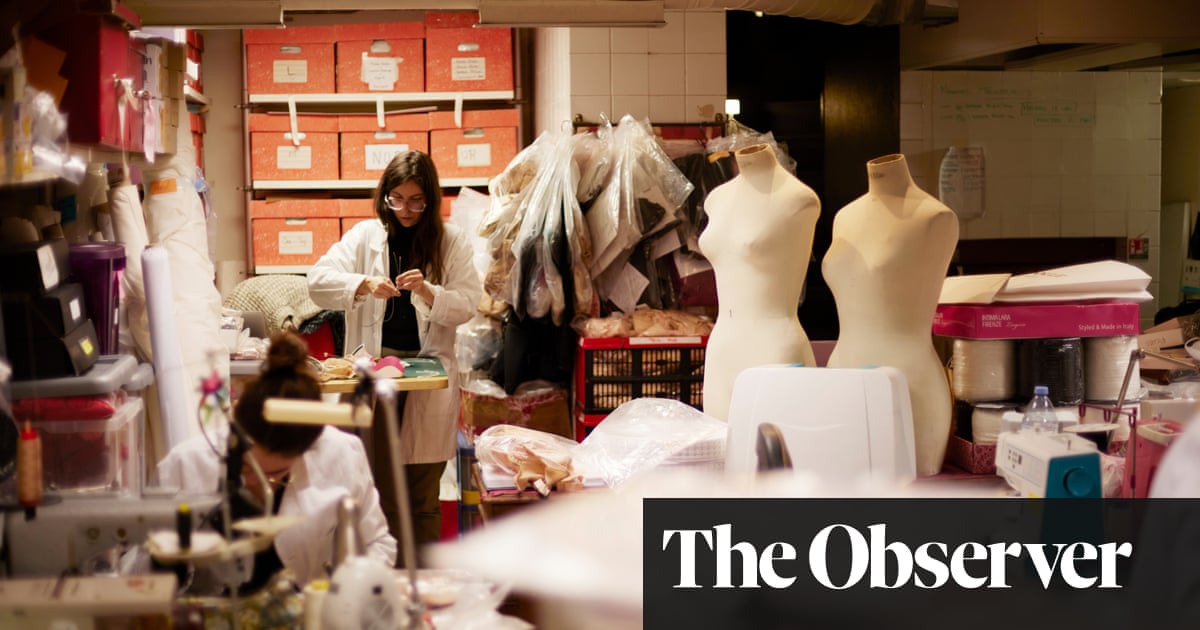Down a passageway on the Rue Saint-Honoré, in Paris, sandwiched between the startling glamour of Chanel and Saint Laurent, there is a glass door stuck with peeling photographs that make up the Cadolle family tree. This family business has been making corsets since the late 1800s, with current clients including designers such as John Galliano (who hired them to make corsets for his Maison Margiela Artisanal couture show) and stars such as Beyoncé and Lady Gaga.
Poupie Cadolle, now 78, welcomes me into the mirrored salon, “Welcome!” and arranges herself elegantly beside me on a fuchsia sofa, re-tying her silk neck scarf to tell their story. “It’s a very long story!” she warns, leaning in.
The business is now run by Poupie’s daughter, Patricia, while Poupie concentrates on the couture fittings, but “It started with my great-great-grandmother Herminie Cadolle, who was a very strong personality. She was a feminist and an anarchist. She spent a lot of time in prison.” Upon release, Herminie “decided to liberate the woman from the corset, and she patented the very first bra ever made, in 1889, presenting it at the World Fair where they built the Eiffel Tower.” She points to a high shelf where this, the very first bra ever made, watches over the room: imperious, cream, covetable. The trick was elastic straps. They allowed women to live more functional lives, unbound by corsetry and, as women reshaped their bodies and place in society, the business grew. Poupie learned how to fit and design first from her mother, then from two mentors in the 1980s, Monsieur Bernardin, dressing nude dancers at the Crazy Horse Saloon, and the couturier Azzedine Alaïa, “Genius men who were in love with the women’s figure.”
Much has changed, much has remained, “but the bodies are completely different today. Women have no more waists! Because women don’t wear girdles any more, so the women never trained their waistline to be thin.” She’s seen “many, many breasts and they are all so different.” When she started in the boutique, the largest size they stocked was a B cup. Today, “I have a customer with a K cup. And in a lingerie show I saw a booth doing an N cup!” She motions with her hands. Her regular customers pay from €900 for a custom bra. They fly in from the US or Middle East, and sit here in her velvet-curtained room, and tell her about their life. “I have to know who she is, how she feels about her body – sometimes she hates herself. I have to know what she needs. What they usually say they need is, ‘A good bra.’ Which means, first it looks good and second that she doesn’t need to remove it as soon as she gets home.” Downstairs, a messy atelier is lined with boxes and wooden plan chests, each containing customers’ patterns – among them, four young women chuckle and sew carefully. It’s highly technical work, despite the distractions of blue silk and slippery lace.
Poupie loves lace and mourns lingerie of the past, mourns a bow, mourns a ruffle. “In some countries we are losing the essence of being a woman!” she tuts. “Bras or lingerie that is boring? That looks like a bandage when you cut your finger? For us it’s very frustrating.” There has been, she thinks, “A fight against lingerie, because it was used as a symbol of oppression – women thought that they didn’t need pretty things to wear underneath to seduce men. But forgot they could still wear them for themselves!” She’s watched (and slowly adapted to) the popularity of the thong and with it the rise of the bottom. “Working with Galliano last year for the show, they were adding fake bottoms, extreme ones, and since then I’ve seen in the street in Paris recently, some girls, not always that chic, with fake ones too.” She chuckles remembering a story about a pop star (redacted) she made lingerie for, who “was singing on a show and her bottom blew up! The implant exploded!”
Cadolle is happy to make “porno chic” lingerie, as long as the fabrics are exquisite. “When it’s beautiful you can get away with it, if the woman herself behaves!” As Poupie attends to a fitting (should the buttocks be covered by lace?) my mum messages – was I going to buy a bra? “No, they cost €900,” I replied. “You could pay someone to carry your breasts around for a year for that,” she gasped. No need – in the UK we’re lucky, says Poupie, because we have Marks & Spencer. “Their bras are so good – technically they are wonderful. They are boring, but they’re good, and very innovative, with things like the uplift for the bottom.”
Does Cadolle do uplift for the bottom too? “Of course! I reshape the body completely, the way they want to be reshaped. That’s what I love to do.” She spoils her customers, she smiles. “Because I love them. I really do.” She leans forward. “Now, would you like to meet my daughter?”
Round the corner, past Dior, Patricia greets us behind the counter of the boutique, where they stock the ready-to-wear lines. “We never agree with each other,” Patricia explains (her silk scarf is barely visible above the collar of her shirt), “but we always find the in-between. That’s really the point of working through generations – when you are young, you don’t need structure. So you don’t realise it’s very technical, you just look at the visual effect. And she teaches me the final result.”
Behind her a wall of drawers contains hundreds of pairs of knickers, nestled together like birds. “In a regular business you don’t dare say what you think, whereas of course, with mother and daughter, you have to!” Poupie nods. “We are not doing a career, we are just doing our work, to improve the products and the knowhow the family has grown.”
Patricia grew up in the atelier – that she’d end up here, she says, was inevitable. “But now she sees much further than I do” says Poupie. “I’m more in the moment. She’s more in the future. She has more, comment on peut dire – une analyse différente?”
When she was a teenager, says Poupie, she fought terribly with her mother, who had banned her from wearing tights. “She said she thought it was vulgar. But she was smart because she knew that the tights would ruin our business. They removed girdles, garter belts, merry widows, everything that would hold the stockings. And then when women started wearing trousers, it killed the lingerie business. So now all that’s left is bras.” With the popularity of soft cups and comfort being prioritised, could they be disappearing, too? “They are trying! But then we wait.” Yes, says, Patricia.
“The woman has such different bodies all her life. And everything changes, the bust, the volume – the older you get, the more it needs to be supported.” The luxury goods market declines each year – how will a 136-year-old couture lingerie brand adapt? “The market is shrinking, but we’re still here, because we’re still loyal to who we are, and what we represent.” While other luxury brands, they say, have tried to be competitive and lower their prices, “We didn’t, because we are very small and because we are not able to do a bra with bad lace.” Poupie shudders gently at the thought. “That doesn’t work, that’s not Cadolle.”
Article by:Source: Eva Wiseman











